
Library management systems
Ex Libris library management systems
After securing a Premier Partnership Agreement in 2001 with Ex Libris, a leading provider of library automation systems, the Library moved to upgrade its systems to the full range of Ex Libris products, completing the process by the middle of 2002 and becoming the first partner worldwide to do so.
The installation of Ex Libris’ ALEPH 500 library system, MetaLib and SFX delivered benefits to Library clients through a single interface for the catalogue with broadcast searching capabilities.
Sue White, in her capacity as Acting University Librarian for the period between the departure of Vicki Williamson in November 2001 and the arrival of Imogen Garner in July 2003, oversaw this migration of the Library system to the ExLibris range of products.
The University recognised the achievement by granting a Vice Chancellor’s Award for Excellence in 2002 to the Library staff involved with the implementation of the systems.
Digital archives using Ex Libris Digitool
Under the Partnership Agreement, Library staff and Ex Libris developers worked collaboratively to develop the company’s asset management system Digitool so that it could manage archival collections in a digital environment. The John Curtin Prime Ministerial Library’s (JCPML) archival collection was used as the model.
In 2003, the JCPML’s Electronic Research Archive (ERA) was migrated to the new Digitool platform, bringing significantly improved functionality to client access as well as workflow efficiencies for Library staff. ERA delivered seamless access to digital objects as images, fully searchable text, audio and video, whilst still preserving the hierarchical context of objects, an important consideration for archival materials.
Upgrades and additions - Ex Libris products
Throughout the decade, the work of upgrading to new versions of the Ex Libris products as they became available was significant. Each new version or additional product brought improvements, such as better control and efficiency in managing collections and processes 17 and enhanced access for clients in finding information in an increasingly electronic environment.
For example, automated RSS feeds were introduced in 2005 to alert clients to recent additions to the catalogue.
The Ex Libris product Verde was implemented in 2007 for the management of the Library’s electronic collections, bringing improvements in workflows, budget management and collection development.
In 2008, the digital theses collection was moved to Digitool and the following year, the institutional repository, espace@Curtin, also migrated to the Digitool platform.
A new generation online catalogue
In late 2009, the Library implemented a beta version of a new generation online catalogue interface which used the Ex Libris product Primo. The introduction of Primo and Primo Central fundamentally changed the way students and staff searched for information.
The catalogue worked with existing library systems to provide clients with enhanced search functionality and web 2.0 features such as tagging. It was a big step towards providing seamless searching across multiple collections, allowing traditional catalogue material, archival collections, research papers and selected journal indexing databases to be retrieved in a single search.
Accessing digital content became easier as the catalogue moved to link seamlessly to digitised content, regardless of whether the material was part of the Library’s own eReserve, espace, or archival collections, or available to Curtin users via the Library’s subscriptions to journal databases and e-book sets, or freely available to all in the public domain.
There was a changeover period of about 12 months when the previous catalogue was also maintained to give clients time to adjust to the changed functionality and to allow refinement of the Primo interface and resolution of identified issues.
The Library announced the changeover in time for the start of semester in 2011 - ‘Catalogue upgrade helps meet expectations of Google generation‘.18 By that time, the catalogue had been integrated with Primo Central, a mega-archive containing hundreds of millions of online journal articles and e-books which could be searched simultaneously with Curtin’s local content. Over 90% of the Library’s subscribed peer reviewed journal content was available and the percentage continues to grow.
The new catalogue afforded users opportunities to be participants and not just spectators through social networking functionality such as user tagging, rating and reviews. Clients could also personalise their access, create alerts for regular updates on new content, store their records and searches, and share their results with others.
New generation library systems
By the end of the decade, a number of companies had begun development of products which aimed to integrate and manage the diverse collection-related activities of libraries in the electronic environment. In the past, development had centred on improving existing systems which dated from the time when collections were largely print based.
Recognising the complexities of dealing with electronic material, the new generation library systems are being built from the ground up, considering the needs of libraries into the 21st century.
The Library is currently considering options for moving to one of these new products.
Loans
The number of loans of physical items in the collection, while still significant, has decreased in recent years. In 1994, 484 000 loans were made and a decade later the figure was 463 000.
Reflecting the impact of the availability of e-books, e-Reserve and other electronic information sources, the number of loans in 2011 was down 35% on the 2004 figure to just under 302 000.
Electronic document delivery
By mid 2003, the Library had implemented the Local Inter-lending and Document Delivery Administration System (LIDDAS) to manage document delivery. This enabled Curtin clients to initiate document delivery and loan requests via the Library’s website.
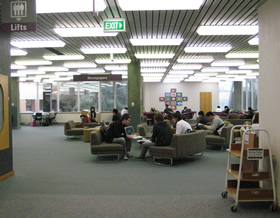 Clients making use of the wireless network and comfortable seating on level three, 2008.
Clients making use of the wireless network and comfortable seating on level three, 2008.
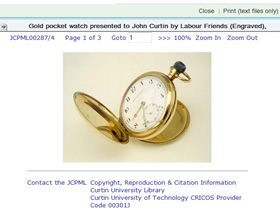 A screenshot from the JCPML's Electronic Research Archive running on the Ex Libris Digitool platform, 2012.
A screenshot from the JCPML's Electronic Research Archive running on the Ex Libris Digitool platform, 2012.
 Screenshot of espace@Curtin search page, 2012.
Screenshot of espace@Curtin search page, 2012.
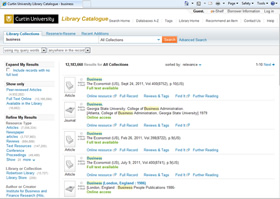 Screenshot of results page of a search on 'business' in the Library catalogue, running on Ex Libris Primo Central platform, 2012.
Screenshot of results page of a search on 'business' in the Library catalogue, running on Ex Libris Primo Central platform, 2012.
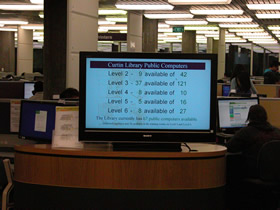 Clients could check the availability of computers in Robertson Library via these large screen displays, 2008.
Clients could check the availability of computers in Robertson Library via these large screen displays, 2008.
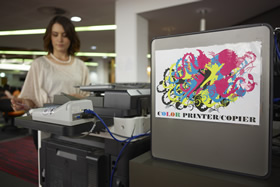 A colour printer/copier in the iZone, 2011.
A colour printer/copier in the iZone, 2011.
Computers, printers and photocopiers for client use in the Library were regularly upgraded to ensure they met client requirements.
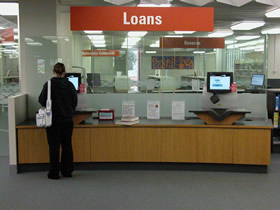 A client borrowing items using one of the self-service terminals on level two, 2007.
A client borrowing items using one of the self-service terminals on level two, 2007.
Within three years, the system was able to deliver electronic documents directly to clients’ desktops. The efficiencies meant the Library was able to reduce the costs for clients and in May 2008, all document delivery charges were dropped. Not surprisingly, this proved popular with clients and demand for the service increased.